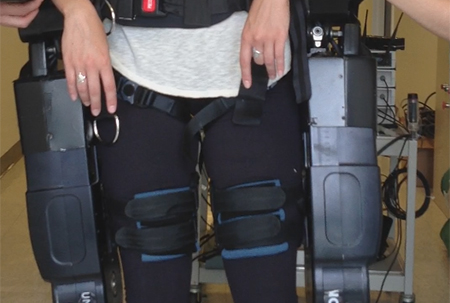You saw the movie Iron Man, right?
Ever since he shot across the sky a decade ago in a self-made rocket-propelled exoskeleton, Iron Man charged viewers’ imaginations, some dormant since the JFK space age.
The technology behind sci-fi in the movies is fun, and it’s super-cool. But here’s where it gets real — helping our patients walk again by building machines here on terra firma.
Enter NeuroRex, a Houston Methodist prototype of brain-controlled wearable robotics who ambulated on the scene in 2013.
NeuroRex was the brainchild of Dr. Robert Grossman, professor in the Department of Neurosurgery, and Dr. Jose Luis Contreras-Vidal, head of the Noninvasive Brain-Machine Interface (BMI) Systems Lab at the University of Houston and a full affiliate of the Research Institute and Director of the Industry-University Collaborative Research Brain Center at the University of Houston.

Robotic exoskeletons. Helping patients walk again.
Since that time, these pioneers have taken remarkable strides in making independent mobility possible.
Others also have gotten in on the action. The U.S. Food and Drug Administration approved the first personal exoskeleton in 2014. A year later, the Department of Veterans Affairs began funding exoskeletons for qualifying veterans.
Today, a number of companies are vying to develop a user-friendly suit. Meanwhile, Houston Methodist is taking wearable robotics to the next level to restore, augment or assist whole body movement.

Robotic exoskeletons. Helping patients walk again.
Our researchers have amped up their progress with noninvasive BMI systems based on scalp EEGs that record brain waves to control robotic exoskeletons and prosthetic limbs.
We’re restoring motor function in individuals with spinal cord injuries, stroke effects and limb amputation. Plus, we’ve continued fine-tuning a true human-machine nexus, enabling individuals to control the technology using their brains.
“We’ve advanced to the level of neural intent detection in our exoskeleton models,” said Dr. Philip Horner, neuroregeneration professor, Institute for Academic Medicine. Meaning, your brain can direct the technology in the robotic legs to put one foot in front of the other.
Electrodes in a skull cap fire off directions to the exoskeleton, essentially reading the wearer’s mind. The body does this function fluidly, and with little thought on our part. That’s the goal with wearable robotics. To make them simple, intuitive and easy to use.
What’s coming.
The goal for the future is to get people with limited mobility to walk and run with lightweight, fully integrated soft robotics that are simple to wear. Our researchers envision people wearing something like Bluetooth headsets, an approach that’s less expensive and less invasive.
Gait rehab for stroke patients. The ability to walk upright for paraplegics and amputees. We’re working toward a minimalist outfit that’s as easy to manage as getting dressed.
Houston Methodist — even cooler than Iron Man.
